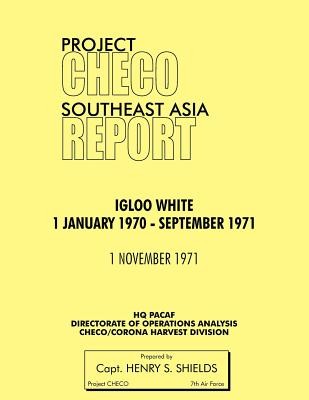
- We will send in 10–14 business days.
- Author: Henry S Shields
- Publisher: MILITARY BOOKSHOP
- ISBN-10: 1780398050
- ISBN-13: 9781780398051
- Format: 21.6 x 27.9 x 1.1 cm, softcover
- Language: English
- SAVE -10% with code: EXTRA
Reviews
Description
High quality reprint of a recently declassified 1971 study. IGLOO WHITE originated as part of a September 1966 plan to interdict North Vietnamese infiltration into the Republic of Vietnam (RVN). Originally called PRACTICE NINE, the plan was renamed MUSCLE SHOALS before it was finally designated IGLOO WHITE in June 1968. PRACTICE NINE included two subsystems: a Strong Point Obstacle sub-System (SPOS), and an air-supported anti-infiltration subsystem stretching westward from the SPOS into Laos to interdict the Ho Chi Minh Trail through central and eastern Laos, by which the enemy supplied his forces in South Vietnam. The Laotian part of the plan envisioned the emplacement of both sensor devises and special munitions to detect and impede this traffic. By July 1968, however, the munitions part of the program had proved to be relatively ineffective, and the use of air-delivered electronic ground sensors for reconnaissance purposes became the primary feature of the system. IGLOO WHITE consisted of three main components. The first component consisted of battery-powered sensing devices which detected seismic, acoustical, or electrical signals generated by the presence of enemy vehicles or personnel. The sensors were either implanted in the ground or were para-dropped and allowed to hang in the upper layers of the jungle canopy. The second component was an airborne platform (EC-121R, QU-22B, or C-130) designed to monitor the sensors and either re]ay the information to a ground facility or have it manually read out by specially trained personnel aboard the aircraft. The third component was an Infiltration Surveillance Center (ISC) which received sensor data from the airborne monitor and performed detailed intelligence analysis of enemy movement patterns as well as relayed the Information to strike aircraft in useable form for immediate action. This facility was provided by Task Force Alpha (TFA), which began operations at Nakhon Phanom Royal Thai Air Force Base, Thailand, on 1 December 1967.
EXTRA 10 % discount with code: EXTRA
The promotion ends in 20d.23:21:49
The discount code is valid when purchasing from 10 €. Discounts do not stack.
- Author: Henry S Shields
- Publisher: MILITARY BOOKSHOP
- ISBN-10: 1780398050
- ISBN-13: 9781780398051
- Format: 21.6 x 27.9 x 1.1 cm, softcover
- Language: English English
High quality reprint of a recently declassified 1971 study. IGLOO WHITE originated as part of a September 1966 plan to interdict North Vietnamese infiltration into the Republic of Vietnam (RVN). Originally called PRACTICE NINE, the plan was renamed MUSCLE SHOALS before it was finally designated IGLOO WHITE in June 1968. PRACTICE NINE included two subsystems: a Strong Point Obstacle sub-System (SPOS), and an air-supported anti-infiltration subsystem stretching westward from the SPOS into Laos to interdict the Ho Chi Minh Trail through central and eastern Laos, by which the enemy supplied his forces in South Vietnam. The Laotian part of the plan envisioned the emplacement of both sensor devises and special munitions to detect and impede this traffic. By July 1968, however, the munitions part of the program had proved to be relatively ineffective, and the use of air-delivered electronic ground sensors for reconnaissance purposes became the primary feature of the system. IGLOO WHITE consisted of three main components. The first component consisted of battery-powered sensing devices which detected seismic, acoustical, or electrical signals generated by the presence of enemy vehicles or personnel. The sensors were either implanted in the ground or were para-dropped and allowed to hang in the upper layers of the jungle canopy. The second component was an airborne platform (EC-121R, QU-22B, or C-130) designed to monitor the sensors and either re]ay the information to a ground facility or have it manually read out by specially trained personnel aboard the aircraft. The third component was an Infiltration Surveillance Center (ISC) which received sensor data from the airborne monitor and performed detailed intelligence analysis of enemy movement patterns as well as relayed the Information to strike aircraft in useable form for immediate action. This facility was provided by Task Force Alpha (TFA), which began operations at Nakhon Phanom Royal Thai Air Force Base, Thailand, on 1 December 1967.


Reviews